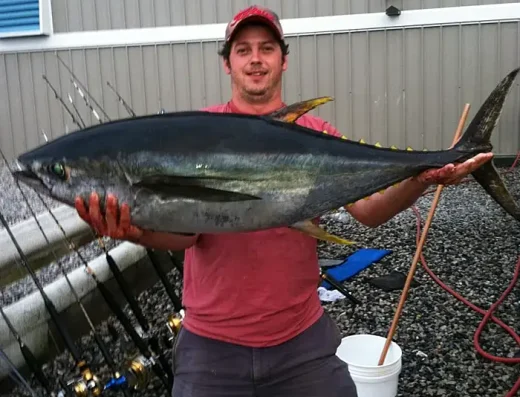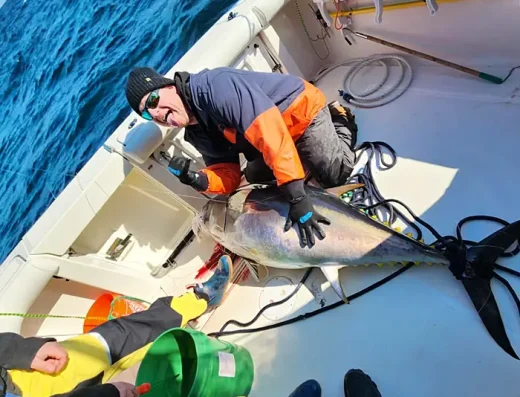Norfolk Fishing Charters
Norfolk fishing charters put anglers on the Elizabeth River, Chesapeake Bay, and nearshore Atlantic waters for striped bass, red drum, speckled trout, cobia, and flounder.
Top Rated Charters in Norfolk
TrustedFish connects anglers with proven local captains in Norfolk, Virginia —no commissions, no pay-to-play listings, no BS. Every charter on our platform is invite-only, vetted for skill, local knowledge, and reputation. If they’re listed, they’ve earned it.
Norfolk, VA Fishing Guide
Norfolk sits in the heart of Virginia’s Tidewater region, with direct access to the Elizabeth and Lafayette Rivers, the mouth of the James River, and the vast Chesapeake Bay. Charter trips here run anywhere from half-day light tackle outings in the rivers to full-day Bay runs and longer excursions that push out through the Chesapeake Bay Bridge-Tunnel into nearshore Atlantic waters. Inshore structure includes grass flats, piers, deep channels, and oyster beds, while the Bay offers artificial reefs, wrecks, and open water rips where larger migratory species stage.
Most trips launch from Waterside Marina, East Ocean View, or nearby Little Creek, depending on target species and tide. Typical run times are short—often less than 20 minutes to the first fishing grounds in the Elizabeth or Lafayette Rivers. Running east through the Bay, charters may stretch runs to 30–45 minutes when chasing cobia, spadefish, or Spanish mackerel near the Bridge-Tunnel or Cape Henry. Offshore runs from Norfolk are less common than from Virginia Beach, but captains here still target seasonal tuna, mahi, and billfish with longer all-day trips.
The fishery shifts with the seasons. Spring brings speckled trout, puppy drum, and early stripers back into the rivers. Summer marks prime cobia, flounder, and spadefish fishing across the Bay. Fall is all about big bull reds and striped bass as they migrate through the Chesapeake. Winter slows but still produces rockfish action in deeper channels when conditions allow. Techniques vary by target—live baiting with spot or eels for cobia and stripers, jigging bucktails and soft plastics for trout and flounder, chumming and sight-casting for red drum, and trolling spoons or planers for mackerel and bluefish. Fly fishing also sees strong action on the rivers for trout and schoolie stripers.
With so many connected waterways, anglers can shift easily between the Elizabeth River, James River, Chesapeake Bay, and nearby creeks, making Norfolk one of the most versatile saltwater fisheries on the East Coast.
Fishing Seasons in Norfolk
Spring (March–May)
Spring fishing in Norfolk focuses on the rivers and creeks as water temperatures climb. Speckled trout return in good numbers, with soft plastics on jig heads and live shrimp producing steady action in the Elizabeth and Lafayette Rivers. Red drum begin showing along grass edges and mud flats, often in schools that can be sight-cast on calm days. Striped bass are still around, especially in the deeper channels of the Elizabeth River, with trolling stretches and live eels working best. Charters tend to favor shorter half-day runs this time of year, as fish are close to the docks and weather patterns can be variable. The water is often stained from spring rains, so anglers rely on bolder lures and scent to draw strikes.
Summer (June–August)
Summer is prime season in Norfolk, with cobia, spadefish, flounder, and mackerel all feeding heavily in the Bay. Cobia arrive in June and are targeted with live eels or croaker, often by sight-casting to fish cruising the surface near buoys and channel markers. Spadefish stack up at the Chesapeake Bay Bridge-Tunnel pilings, and squid strips on small hooks provide nonstop action. Flounder bite peaks in summer on sandy bottoms around deep channels, with bucktails tipped with minnows or squid working well. Spanish mackerel and bluefish are trolled along tide lines, especially in the lower Bay near Cape Henry. Full-day trips are popular in summer, with anglers spreading time between multiple species.
Fall (September–November)
Fall is one of the most productive times in Norfolk, as water cools and migratory fish push through the Bay. Bull red drum run heavy near the Chesapeake Bay Bridge-Tunnel and Cape Charles, often caught with large cut bait or crabs on bottom rigs. Striped bass fishing heats up again, with trolling umbrella rigs or casting plugs into bait schools producing consistent catches. Speckled trout action peaks in the Elizabeth and Lafayette Rivers, with bigger “gator” trout feeding aggressively before winter. Flounder taper off, but sheepshead and tautog provide bottom fishing opportunities near structure. Fall charters often run longer to maximize multi-species action, and anglers enjoy some of the year’s most stable weather and calm seas.
Winter (December–February)
Winter slows things down but doesn’t shut them off entirely. Striped bass are the main draw, with legal keeper fish holding in deeper parts of the Elizabeth River and the Bay. Live eels and jigging spoons work best when water temperatures drop. Speckled trout can still be caught on warmer days in creeks and shallow rivers, though the bite is more challenging. Tautog and sheepshead hold tight to wrecks and rock piles near the Bridge-Tunnel, giving bottom fishing enthusiasts a steady option. Most winter trips are shorter due to weather, but dedicated anglers can still find solid rockfish action close to town.
Gamefish in Norfolk
- Striped Bass – 18–40 lbs. Found in the Elizabeth River channels and lower Chesapeake Bay, best in fall and winter with live eels or trolling umbrella rigs.
- Red Drum – 20–50 lbs. Targeted in fall around the Bay Bridge-Tunnel and near Cape Henry using crabs, cut bait, and sight-casting methods.
- Speckled Trout – 1–6 lbs. Consistent in the Elizabeth and Lafayette Rivers spring through fall, caught on soft plastics, jigs, and live shrimp.
- Cobia – 30–80 lbs. Summer fish in the Chesapeake Bay, sight-cast to fish cruising buoys and channel markers, live eels are top bait.
- Flounder – 2–8 lbs. Found in sandy bottom channels and ledges during summer, taken on bucktails with minnows or squid strips.
- Spanish Mackerel – 1–5 lbs. Summer schools in the lower Bay and near Cape Henry, caught by trolling spoons and planers.
- Spadefish – 2–8 lbs. Thick schools at the Bridge-Tunnel pilings in summer, caught with squid strips on small hooks.
- Tautog – 2–10 lbs. Winter and early spring fish near wrecks and bridge pilings, caught with crabs on bottom rigs.
Norfolk Fishing FAQs
What are the main launch points in Norfolk?
Most Norfolk fishing charters launch from Waterside Marina, East Ocean View, and Little Creek. These provide fast access to the Elizabeth River, Chesapeake Bay, and the Bridge-Tunnel grounds.
How long are typical fishing trips in Norfolk?
Half-day trips are common for inshore river fishing, lasting 4–5 hours. Full-day charters run 6–8 hours and usually cover the Bay and Bridge-Tunnel. Specialty offshore trips last 10–12 hours but are less common from Norfolk compared to Virginia Beach.
What gear is provided on Norfolk fishing charters?
Captains supply all rods, reels, bait, tackle, and safety equipment. Anglers can bring personal gear if preferred, especially fly rods or custom tackle for specific species.
Do I need a fishing license to fish in Norfolk?
No, licensed charter boats cover passengers under the captain’s commercial license. If fishing on your own, anglers need a valid Virginia saltwater fishing license.
When is the best time to fish in Norfolk?
Summer and fall offer the most variety, with cobia, spadefish, and red drum peaking. Spring brings trout and puppy drum, while winter holds solid striped bass action
What techniques are most effective in Norfolk waters?
Live bait rigs, trolling, bottom fishing, and jigging are the most common. Sight-casting is especially popular for cobia and red drum in summer and fall.
What species can I expect on a half-day trip?
Shorter trips focus on speckled trout, puppy drum, striped bass, and flounder in nearby rivers and creeks. These trips rarely require long runs.
Are group trips available in Norfolk?
Yes, both private and shared charters are offered. Group size typically ranges from 2–6 anglers, depending on vessel size and trip type.
Do charters offer specialty trips like night fishing?
Some captains run night trips for striped bass and speckled trout, particularly in the Elizabeth River. These can be highly productive in cooler months.


